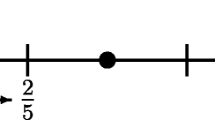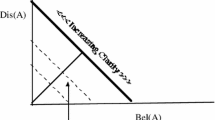Abstract
It is common knowledge that asking a question in different ways can produce different responses. But do different objective response alternatives for the same question produce different results? A questionnaire stating a proposition about the risk of an accident in a nuclear power plant was given to 478 relatively well-educated Japanese representing an even distribution of males and females and divided across various cities, ages, salaries, and occupations. Each respondent was asked to respond using each of four objective methods: (1) simple true or false, (2) true or false with probability weightings, (3) true or false or "no idea", and (4) surely true, probably true, ambivalent, probably false, and surely false. Response alternatives in method 3 are a simple version of the categories used in Dempster-Shafer belief theory and those of method 4 are a simple example of fuzzy sets. Not surprising to the statistician, results showed large numerical differences between forced-choice T–F frequencies and the "subjective probability" T–F response averages (i.e., between methods 1 and 2). Methods 3 and 4 could be shown to yield comparable results to method 2 by means of a simple transformation for allocating the central uncertainty weightings to either true or false. Chi-square tests showed no significant differences between subcategories within each of the attributes of City of Residence, Gender, Age, Salary, and Occupation.
Similar content being viewed by others
References
Arrow K (1951) Social choice and individual values. Wiley, New York
Guilfod JP (1954) Psychometric methods. McGraw Hill, New York
Inagaki T (1993) Dempster-Shafer theory and its applications. In: Misra KB (ed) New trends in reliability evaluation. Elsevier, Amsterdam, pp 587–624
Likert R (1932) A technique for the measurement of attitude scales. Arch Psychol NY, no. 140
Linstone HA, Turoff M (eds) (1975) The Delphi method. Addison Wesley, Reading, MA
Luce RD (1959) Individual choice behavior. Wiley, New York
Luce RD, Bush RR, Galanter E (eds) (1962) Handbook of mathematical psychology. Wiley, New York
Schum DA (1994) Evidential foundations of probabilistic reasoning. Wiley, New York, chap 5
Sheridan TB (1975) Community dialog technology. Proc IEEE (Special issue on social systems) 63(3):463–474
Sheridan TB (1998) Technical safety and social safety. In: Proceedings of symposium on humans and technology, Institute of Nuclear Safety Systems, Mihama, Fukui, Japan, 21–22 September
Acknowledgements
This research was sponsored by the Institute of Nuclear Safety System, 64. Sata, Mihama-cho, Makata-gun, Fukui 919-1205, Japan. We are in indebted to Prof. Neville Moray for key suggestions.
Author information
Authors and Affiliations
Corresponding author
Questionnaire
Questionnaire
Figure 1 shows the questionnaire used in this experiment.
Rights and permissions
About this article
Cite this article
Sheridan, T., Niwa, Y. An experiment on measuring belief: asking the same question in different ways. Cogn Tech Work 5, 206–210 (2003). https://doi.org/10.1007/s10111-003-0118-y
Received:
Accepted:
Published:
Issue Date:
DOI: https://doi.org/10.1007/s10111-003-0118-y





